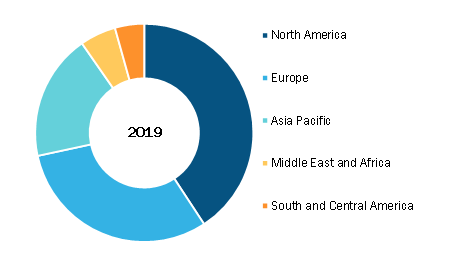Market for Laser-Based Dermatology Treatment Devices to Grow at Highest CAGR during 2020–2027
According to our new market research study on “Dermatology Treatment Devices Market to 2027 – COVID-19 Impact and Global Analysis – by Product Type, Application, and End User,” the market is expected to reach US$ 8,800.07 million by 2027 from US$ 5,320.73 million in 2019; it is estimated to grow at a CAGR of 6.7% during 2020–2027. Factors such as rising prevalence of skin issues and technological advancements in dermatology treatment devices boost the growth of the market. However, the risk of undesirable side effects associated with the use of dermatology treatment devices hinders the market growth.
On the basis of product, the dermatology treatment devices market was segmented into lasers, light therapy devices, energy-based therapies devices, microdermabrasion devices, microneedling, and cryotherapy devices. In 2019, the lasers segment accounted for the largest share of the market, and it is likely to continue to be the largest shareholder in the market during the forecast period. The market growth of this segment is attributed to the factors such as increasing adoption of lasers for aesthetic and dermatology issues, rising adoption of laser-based procedures, ease of the treatment, and reliability of the procedure results. In addition, the development of low-cost lasers for residential use acts as a major growth opportunity for the dermatology treatment device market players.
The healthcare sector has been witnessing rapid transformations since the past few years. As per European Union, the global middle-class population is expected to reach 5.3 billion by 2030, and Asia is likely to account for a maximum share of this population. By 2030, China and India together are expected to represent ~66% of the global middle-class population and 59% of middle-class consumption. The expansion of middle-class, with significant changes in consumer behavior and consumption patterns, would drive economic development in the world. For example, according to the US Bureau of Labor Statistics, the disposable income in the US increased from US$ 10,036.9 billion in 2006 to US$ 13,968.6 billion in 2016, and it is further expected to reach US$ 21,178.2 billion by 2026. With increase in disposable incomes, changes in technology, and better after-care, a general attitude toward skin-related conditions has changed. This has led to the mounted adoption of dermatological procedures and home-based medical devices to treat skin conditions. These conditions encourage multinational corporations in the beauty and skin care industry to target massive populations, especially the growing middle-class population, in countries such as India and China.
The COVID-19 pandemic was first reported in December 2019 in Wuhan (China). The impacts of this outbreak are being felt across several markets in the world. The demand for dermatology treatment devices has reduced amid this global crisis due to a significant shift in the focus toward the management, treatment and prevention of COVID-19. The pandemic is continuing to worsen around the world leading to massive disruptions in global supply chains, consumer markets, and economies, and these conditions are also restraining the growth of the dermatology treatment devices market.
Cutera Inc.; Bausch Health Companies Inc.; Sciton, Inc.; Lumenis; Alma Lasers; Cynosure, Candela Corporation; Biofrontera Ag; Avita Medical; and PhotoMedex are among the leading companies in the dermatology treatment devices market.
Dermatology Treatment Devices Market, by Region, 2019 (%) 
Dermatology Treatment Devices Market Forecast and Size - 2031
Download Free Sample
Dermatology Treatment Devices Market Size and Forecast (2021 - 2031), Global and Regional Share, Trend, and Growth Opportunity Analysis Report Coverage: By Product Type (Lasers, Light Therapy Devices, Cryotherapy Devices, Microdermabrasion Devices, Energy-Based Therapies Devices, and Microneedling), Application (Skin Resurfacing, Skin Rejuvenation, Hair Removal, Psoriasis, Scar, Warts and Skin Tags, Hyperpigmentation and Vascular Lesions, Acne, Tattoo Removal, and Hyperhidrosis), End User (Hospitals, SPA Clinics, Dermatology Clinics, and Surgical Centers), and Geography
Dermatology Treatment Devices Market Forecast and Size - 2031
Download Free SampleDermatology Treatment Devices Market Size and Forecast (2021 - 2031), Global and Regional Share, Trend, and Growth Opportunity Analysis Report Coverage: By Product Type (Lasers, Light Therapy Devices, Cryotherapy Devices, Microdermabrasion Devices, Energy-Based Therapies Devices, and Microneedling), Application (Skin Resurfacing, Skin Rejuvenation, Hair Removal, Psoriasis, Scar, Warts and Skin Tags, Hyperpigmentation and Vascular Lesions, Acne, Tattoo Removal, and Hyperhidrosis), End User (Hospitals, SPA Clinics, Dermatology Clinics, and Surgical Centers), and Geography
The report segments global dermatology treatment devices market as follows:
By Product Type
- Lasers
- Light Therapy Devices
- Cryotherapy Devices
- Microdermabrasion Devices
- Energy-Based Therapy Devices
- Microneedling
By Application
- Skin Resurfacing
- Skin Rejuvenation
- Hair Removal
- Psoriasis
- Scars
- Warts and Skin Tags
- Hyperpigmentation and Vascular Lesions
- Acne
- Tattoo Removal
- Hyperhidrosis
By End User
- Hospitals
- Spa Clinics
- Dermatology Clinics
- Surgical Centers
By Geography
- North America
- US
- Canada
- Mexico
- Europe
- France
- Germany
- UK
- Spain
- Italy
- Asia Pacific (APAC)
- China
- India
- Japan
- Australia
- South Korea
- Middle East and Africa (MEA)
- Saudi Arabia
- UAE
- South Africa
- South and Central America (SCAM)
- Brazil
- Argentina